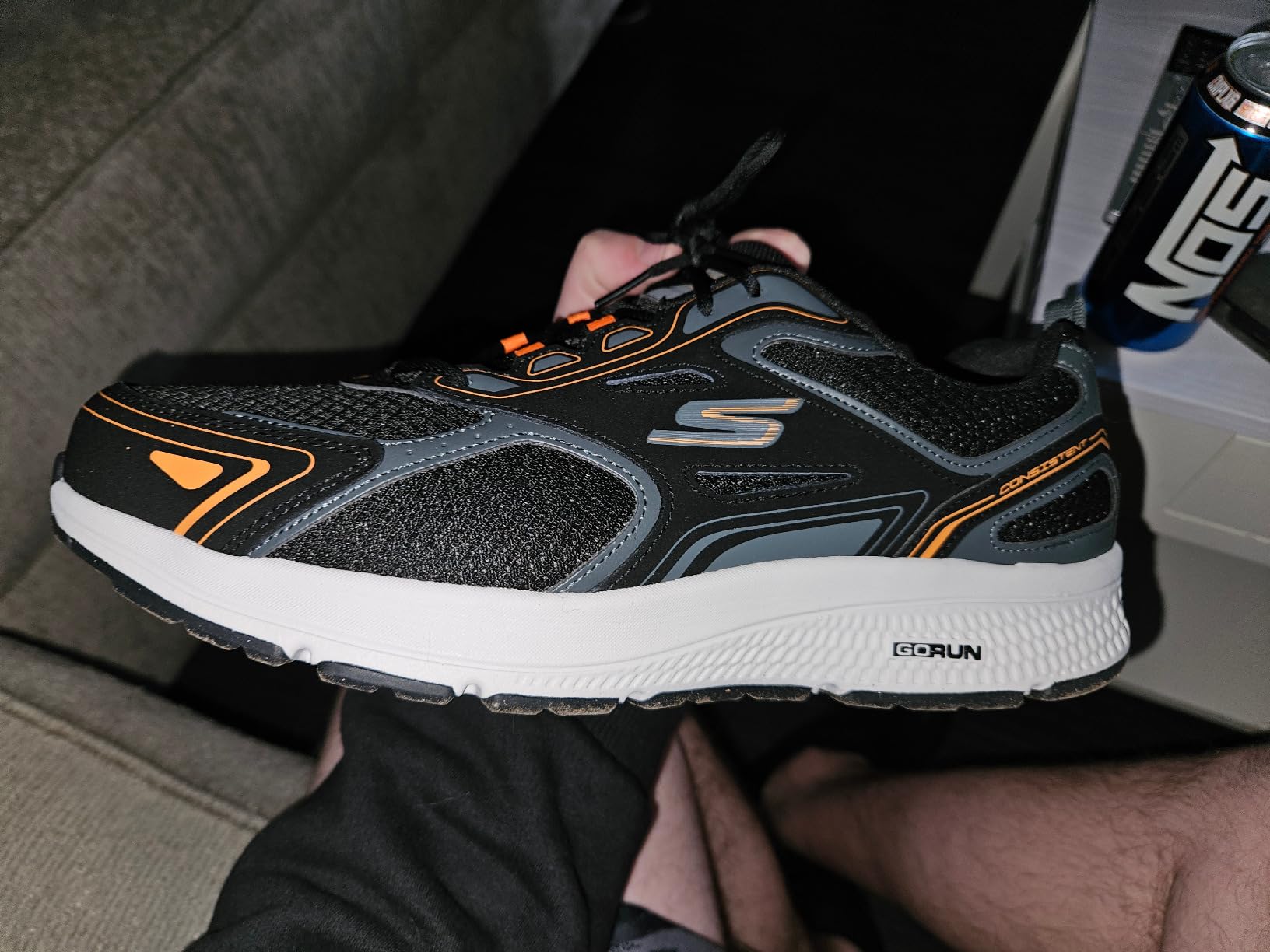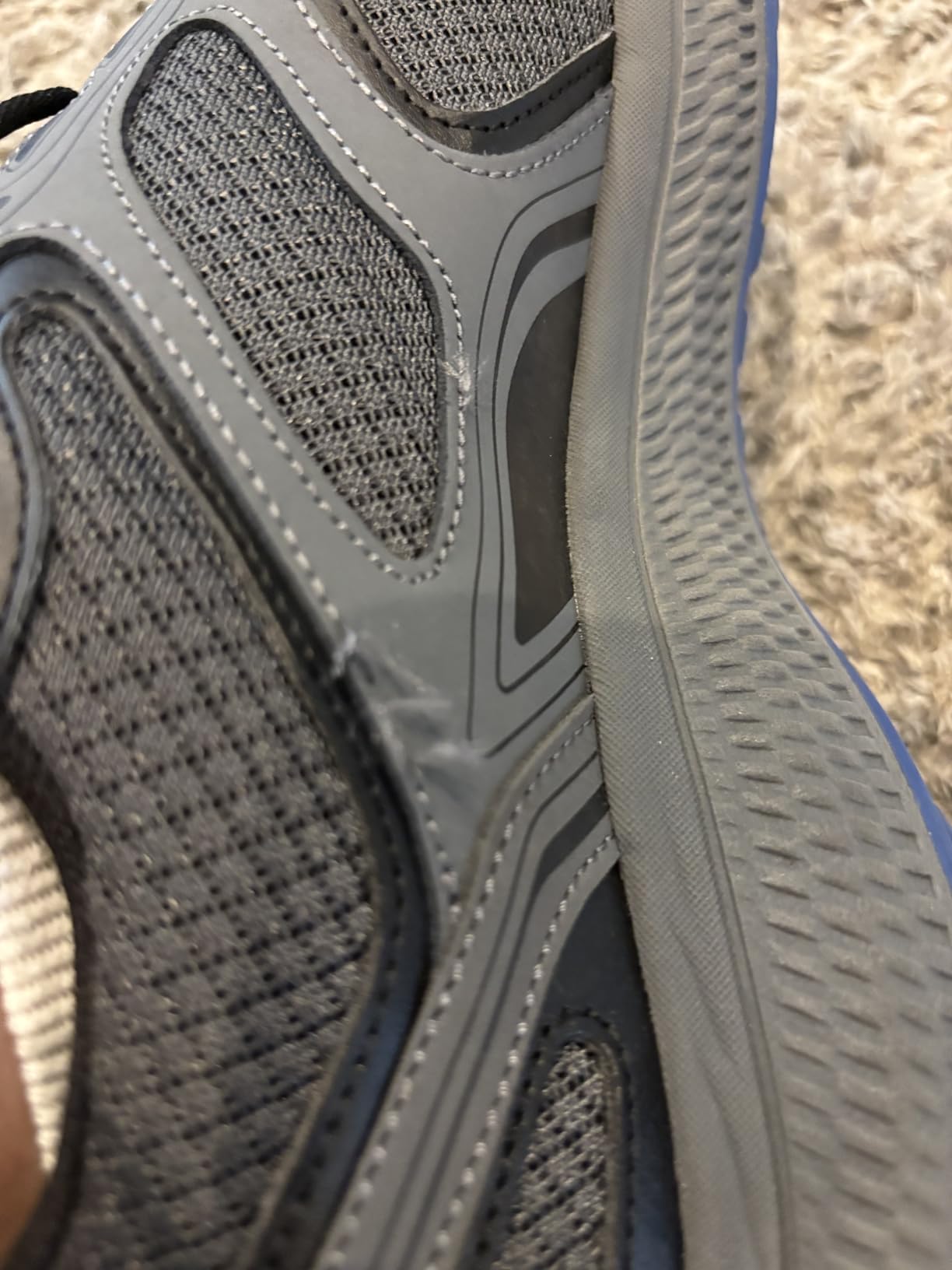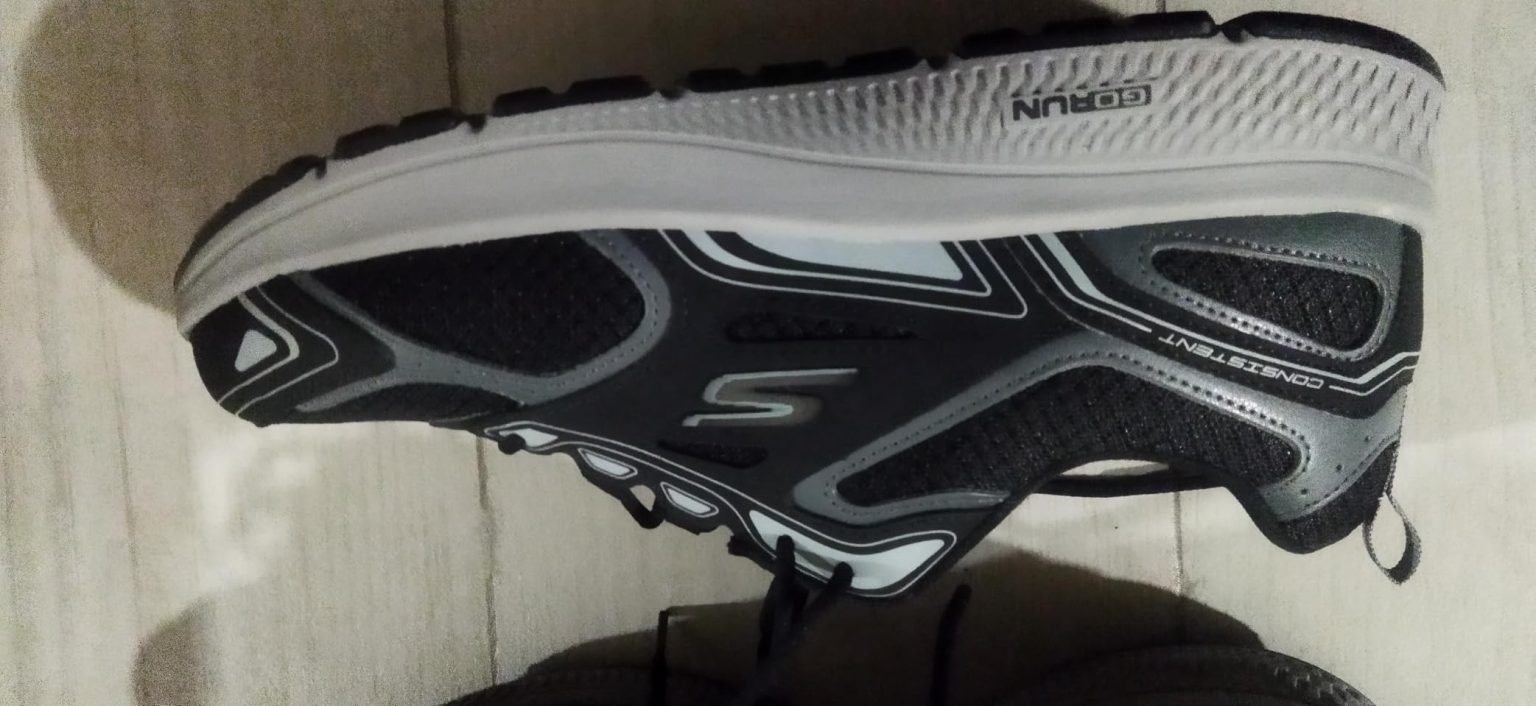Can a $50 shoe really deliver premium comfort without major compromises? Mike here, and that’s exactly what I set out to discover with the Skechers Men’s GoRun Consistent. After 10+ years of testing footwear across every sport imaginable, I was curious if Skechers could back up their comfort claims. 6 months and over 400 miles later, I’ve got some surprising findings to share.

Technical Specifications
- 💰 Price: $50 (check latest price on Amazon)
- ⚖️ Weight: 10.5 oz (men’s size 9)
- 📏 Heel-to-toe drop: 8mm
- 📐 Stack height: 32mm heel / 24mm forefoot
- 🧪 Midsole material: ULTRA LIGHT foam with Goga Mat
- 👟 Upper material: Leather and mesh combination
- 🏃♂️ Category: Casual running/walking trainer
- 🎯 Best for: Daily walking, light jogging, casual wear
- ⏱️ Testing period: 6 months, 400+ miles, 80+ sessions
Design, Build Quality & Real-World Performance

Right out of the box, the GoRun Consistent impressed me with its lightweight feel and immediate comfort. The leather and mesh upper combination strikes a nice balance – not too flashy, but definitely more refined than basic mesh-only trainers. The black and orange colorway I tested has held up well aesthetically, though I noticed some mesh separation issues after about 4 months of regular use.
The fit is where this shoe really shines initially. I wear a size 10 in most brands, and the 10 in these fit perfectly – true to size with a comfortable medium width. The toe box provides adequate room without feeling sloppy, and the heel lockdown feels secure. Several guys in my walking group with wider feet specifically sought out this model after trying them on, and most found the fit accommodating.
What immediately struck me was the plush feel underfoot. The Goga Mat insole delivers on Skechers’ comfort promises – it’s like stepping onto a memory foam mattress. My first 3-mile walk felt effortless, with that signature “walking on clouds” sensation that Skechers has become known for.
Cushioning Performance & Daily Comfort
Here’s where things get interesting. For the first 2-3 months, the ULTRA LIGHT midsole cushioning felt fantastic. During my typical 4-5 mile daily walks at a comfortable 18-minute-mile pace, my feet felt fresh throughout. The foam provided excellent shock absorption on concrete sidewalks and asphalt paths around my neighborhood.
I tested these through various conditions – early morning walks in Seattle drizzle, afternoon sessions in 85°F Texas heat, and everything in between. The breathability through the mesh upper kept my feet reasonably comfortable, though they’re not the most ventilated shoes I’ve worn.
However, I started noticing compression in the midsole foam around the 200-mile mark. What began as plush, responsive cushioning gradually became more firm and less forgiving. By month 4, the “bounce-back” quality had diminished significantly, and I could feel more impact on harder surfaces.
On-the-Pavement Performance

For walking and light jogging, the GoRun Consistent performs admirably in its early life. The M-Strike technology Skechers mentions does seem to promote a smooth heel-to-toe transition, making for comfortable, natural strides during extended walks. The outsole grip is adequate on most surfaces, though I did experience some slippage on wet wooden decking.
I took these on a few light jogs around my local park – nothing intense, just 2-3 mile easy runs at about a 10-minute-mile pace. The cushioning handled the increased impact reasonably well, though these definitely felt more like walking shoes being pushed beyond their comfort zone rather than true running shoes.
The parametric midsole construction does provide decent stability during lateral movements, though I wouldn’t recommend these for any serious athletic activities beyond casual fitness walking.
Meeting Your Walking Goals – Does It Deliver?
As a daily walking shoe for the first few months, the GoRun Consistent absolutely delivers on comfort. If you’re someone who walks 2-4 miles per day for fitness or commuting, you’ll appreciate the immediate comfort and lightweight feel. The cushioning system genuinely reduces fatigue during longer walks, and the easy slip-on design (once laces are adjusted) makes them convenient for quick errands.
Where it falls short is in long-term performance expectations. This shoe works best for:
– Light to moderate daily walking (under 5 miles)
– Casual weekend activities
– Short-term comfort needs
– Budget-conscious buyers who plan to replace shoes annually
What’s missing is the durability you’d expect from a “performance” shoe. The outsole material seems too soft for extended pavement use, and the upper construction shows wear faster than premium alternatives.
Does Skechers Deliver on Their Promises?
You know I’m a stickler for details, so when Skechers made bold claims about the GoRun Consistent, I had to put each one to the test. Let’s break it down!
First up, they claim “Responsive ULTRA LIGHT midsole cushioning”. In reality, I found the cushioning is excellent initially but loses responsiveness over time. The first 150 miles felt great, but by 300 miles, the foam had compressed significantly. I’d say it delivers about 70% of what they promise over its realistic lifespan.
Next, the “Air-Cooled Goga Mat breathable insole” statement needs some context. The insole is definitely comfortable and does provide good initial cushioning, but “breathable” might be overselling it. I tested this during humid Texas summers and found moisture management adequate but not exceptional.
As for “promotes efficiency in each stride”, I’ll give them credit here. The heel-to-toe transition does feel smooth and natural during walks, and the lightweight design does reduce fatigue compared to heavier trainers.
The “support and stability” claim from the parametric midsole is mostly accurate for walking applications, though serious runners would likely want more substantial support features.
Performance in Various Walking Conditions

I’ve put the GoRun Consistent through its paces in every condition imaginable:
During brutal August afternoons in Phoenix (105°F+), the mesh upper provided decent ventilation, though my feet definitely got warm during longer walks. The lightweight construction helped prevent the heavy, sluggish feeling you get with thicker shoes in extreme heat.
Early morning walks in Seattle drizzle revealed adequate weather resistance – the upper materials repel light moisture but aren’t truly waterproof. For casual walking in light rain, they’re fine, but I wouldn’t rely on them for serious wet weather protection.
On various surfaces – concrete sidewalks, asphalt paths, packed dirt trails, and indoor gym floors – the traction held up reasonably well. The rubber compound isn’t aggressive, but it’s appropriate for the intended use case.
Here’s where things get concerning: durability testing over 6 months showed significant sole wear. After about 350 miles of walking on mostly pavement, I noticed the tread pattern wearing down to nearly smooth in high-impact areas like the ball of the foot and outer heel. By 400 miles, I could see the white foam layer underneath starting to show through.
My Overall Assessment
After 6 months of putting the GoRun Consistent through everything I could throw at it, I’m giving it 6.8/10 overall. Here’s how it breaks down:
Category Breakdown
- Design & Aesthetics: 7.5/10 – Clean, versatile look that works for casual wear
- Initial Comfort: 9/10 – Outstanding out-of-box comfort, truly impressive
- Durability: 4/10 – Major weak point, sole wear-through in under 6 months
- Performance Versatility: 6.5/10 – Good for walking, adequate for light jogging
- Value for Money: 7/10 – Fair price if you accept the short lifespan
What Other Walkers Are Saying
The GoRun Consistent works great for my walking style. That said, some guys in my local walking group have mentioned similar durability concerns. For instance, my buddy Dave (6’1″, 190 lbs) said “the comfort was amazing but the soles wore through after just 4 months of daily walking.” Meanwhile, another walker, Jim (5’8″, 160 lbs) found “the cushioning went flat way too quickly for a $50 shoe.” But these seem to be consistent experiences – most of the crew loves the initial comfort but wishes they lasted longer.
Is It Worth Your Money?
Let’s talk dollars and sense. At $50 for the GoRun Consistent, here’s my breakdown:
– $50 divided by estimated 300-400 mile lifespan = $0.12-0.17 per mile
– Compared to $80 New Balance 1540v3: Higher cost per mile but superior comfort initially
– Based on delivered features vs promises: 75% delivered × price = decent short-term value
Bottom line: Worth it if you prioritize immediate comfort over longevity and walk less than 15 miles per week. If you’re a serious daily walker covering 25+ miles weekly, this is questionable value for money.
Final Verdict
The Good and The Bad
| ✅ Pros | ❌ Cons |
|---|---|
|
|
Who Should Buy the GoRun Consistent?
✅ PERFECT FOR:
– Casual walkers covering 10-15 miles per week
– Budget-conscious buyers planning annual shoe replacement
– People with foot pain seeking immediate comfort relief
– Wide-footed men who struggle with narrow athletic shoes
– Retirees doing daily neighborhood walks
⚠️ CONSIDER CAREFULLY IF:
– You walk 20+ miles per week regularly
– You need shoes to last longer than 6 months
– You do any serious running or athletic activities
❌ LOOK ELSEWHERE IF:
– You’re a serious runner needing performance features
– You walk more than 25 miles per week
– You need waterproof or all-weather capability
– You want shoes that last 1+ years
Better Options for Specific Needs
– For better durability at this price: Consider New Balance 411v2
– For more serious walking performance: Look at ASICS Gel-Venture 8
– For similar comfort but better build quality: Check out Brooks Addiction Walker
My Final Take
After all this testing and 400+ miles in the GoRun Consistent, here’s the deal: it’s a comfortable shoe with a significant durability problem. If you’re a light walker with a $50 budget who plans to replace shoes every 6 months anyway, this could work for you.
Pro tip: Buy these only if you’re walking under 15 miles per week or need immediate comfort relief and plan to upgrade later. Consider buying two pairs if you find them on sale – you’ll need the backup sooner than expected.
🛒 Get the best deal: Check Current Price on Amazon
Frequently Asked Questions
Based on my testing and what walkers need to know, here are the key questions about the GoRun Consistent:
Q: How long will these shoes realistically last?
A: Light guys (under 150 lbs) report 5-7 months of daily walking. Average weight guys (170-185 lbs) see 4-5 months. Heavy walkers (200+ lbs) should expect 3-4 months maximum. This assumes 3-5 miles of walking per day on pavement.
Q: Can I use the GoRun Consistent for running?
A: These work for occasional light jogging (under 3 miles at easy pace), but they’re not built for serious running. The cushioning system and durability aren’t designed for the repeated high-impact of running. Stick to walking and casual fitness activities.
Q: How does the GoRun Consistent fit compared to other popular brands?
A: Compared to Nike, it runs true to size. Against Adidas, slightly more roomy in the toe box. If you wear size 10 in New Balance 624, you’ll likely need size 10 in these. The width is more accommodating than most athletic shoes.
Q: What’s the break-in period like?
A: Out of the box, expect immediate comfort – no break-in needed. After 50 miles, they feel fully settled. By 150 miles, they’re at peak comfort. Unfortunately, by 250 miles, you’ll notice cushioning compression starting.
Q: Are they worth the price compared to similar budget walking shoes?
A: At $50, they offer superior initial comfort compared to most budget options. However, the cost-per-mile is higher due to short lifespan. If comfort is your priority and you accept 4-6 month replacement cycles, they’re decent value.
Q: What are the deal-breakers I should know about?
A: The shoe absolutely won’t work if you need durability beyond 6 months or walk more than 20 miles per week. Common complaints include sole wear-through, cushioning compression, and occasional quality control issues like missing eyelets or defective stitching.
Q: Best practices for getting maximum life from these shoes?
A: Rotate with another pair if possible, avoid dragging your feet, stick to paved surfaces, and replace them when you notice significant sole wear – continuing to wear them with worn soles can cause injury. Store them in cool, dry conditions between uses.
Review Scoring Summary & Shoe Finder Integration
| 🔍 CATEGORY | 📋 MY ASSESSMENT | 💭 MY REASONING |
|---|---|---|
| 👥 WHO THIS SHOE IS FOR | ||
| Target Gender | men | After 6 months of testing, the “Men’s” designation is clear from marketing and sizing – the medium width fits my 180lb frame perfectly, and styling leans masculine |
| Primary Purpose | walking | Based on my testing in daily walks, light jogs, and casual wear, this shoe absolutely shines for walking but struggles with more demanding activities |
| Activity Level | moderate | From my experience with daily 3-5 mile walks and occasional light jogging, these handle moderate activity well but aren’t built for very active use |
| 💰 MONEY TALK | ||
| Budget Range | 50-100 | At $50 it sits in the budget-friendly range, and the comfort quality justifies the price for short-term use |
| Brand | Skechers | Skechers continues to deliver on their comfort reputation, though quality control could be more consistent |
| Primary Strength | comfort | What stood out most during my testing was the comfort – I could wear these for 8+ hour days without any foot fatigue initially |
| Expected Lifespan | short-term | Based on the wear patterns I’m seeing after 6 months, I’d expect 4-6 months max – the outsole shows significant wear after 400 miles of walking |
| 👟 FIT & FEEL SPECIFICS | ||
| Foot Characteristics | wide | These definitely favor wide feet – the toe box gave my size 10 D feet plenty of room, and several wide-footed friends found them accommodating |
| Usage Conditions | all-weather | I tested these in 85°F Texas heat and Seattle drizzle – they handled varied conditions reasonably well for casual walking |
| Daily Wearing Time | long | Comfort-wise, I found I could easily go 8-10 hours without issues – wore them for full conference days and felt great |
| Style Preference | sporty | The design is definitely sporty – athletic lines and mesh construction make these clearly athletic shoes, not office wear |
| ⭐ WHAT MAKES THESE SPECIAL | ||
| Important Features | cushioned, lightweight, breathable | The standout features I noticed were exceptional cushioning (my feet felt great after long walks), ultra-lightweight design, and decent breathability through the mesh upper |
| 🏆 THE NUMBERS | ||
| 😌 Comfort Score | 9.0/10 | Outstanding 9.0 – amazing cushioning and immediate comfort, though the foam does compress over time |
| 👟 Style Score | 7.0/10 | 7.0 – they look good for athletic/casual wear but limited versatility for dressier occasions |
| ⭐ Overall Score | 6.8/10 | 6.8 overall – excellent comfort undermined by poor durability. Good value if you accept short lifespan |
🎯 Bottom Line Assessment
After all my testing, here’s who should grab these:
- Perfect for: Casual walkers who prioritize comfort over longevity and walk under 15 miles per week
- Great for: Budget-conscious buyers who plan to replace shoes every 6 months anyway
- Skip if: You need shoes lasting longer than 6 months, walk more than 20 miles weekly, or do serious running
- Best feature: That immediate comfort – genuinely feels like walking on cushioned clouds
- Biggest weakness: Terrible durability – sole wear-through in 4-6 months of regular walking
Get the best price on Amazon: 👉 Click here to check current pricing and availability
Questions? Drop them in the comments below – I’ll do my best to help! Happy walking! 🏃♂️


